Abstract
The malignant growth potential of embryonal carcinoma cells may be controlled by environmental factors. For example, embryonal carcinoma cells placed into normal blastocysts may not exhibit the continued growth expected of malignant cells but rather may lose all aspects of the malignant phenotype and become apparently normal embryonic cells. Loss of the malignant phenotype of embryonal carcinoma cells occurs early in these injected blastocysts and has been used as the basis of assays to study the mechanisms of regulation of embryonal carcinoma by the blastocyst. In this regard, P19, an embryonal carcinoma that makes midgestation chimeras, was regulated by blastocele fluid plus contact with trophectoderm but not by blastocele fluid plus contact with inner cell mass (ICM). In contrast, ECa 247, which makes trophectoderm, was regulated by exposure to blastocele fluid plus contact with trophectoderm or ICM. During the course of these experiments, dead embryonal carcinoma and ICM cells were observed, and blastocele fluid was then shown to kill ECa 247 and normal ICM cells of early blastocysts with trophectodermal potential. P19 cells and ICM cells with potential to make the embryo were not killed by blastocele fluid. Programmed cell death occurs in the ICM of the blastocyst during the transition from early (when ICM has the potential to make trophectoderm) to late (when the ICM lacks the potential to make trophectoderm). It is postulated that this programmed cell death is designed to eliminate redundant ICM cells with trophectodermal potential, and its mechanism of action is mediated by epigenetic factors in blastocele fluid.
Full text
PDF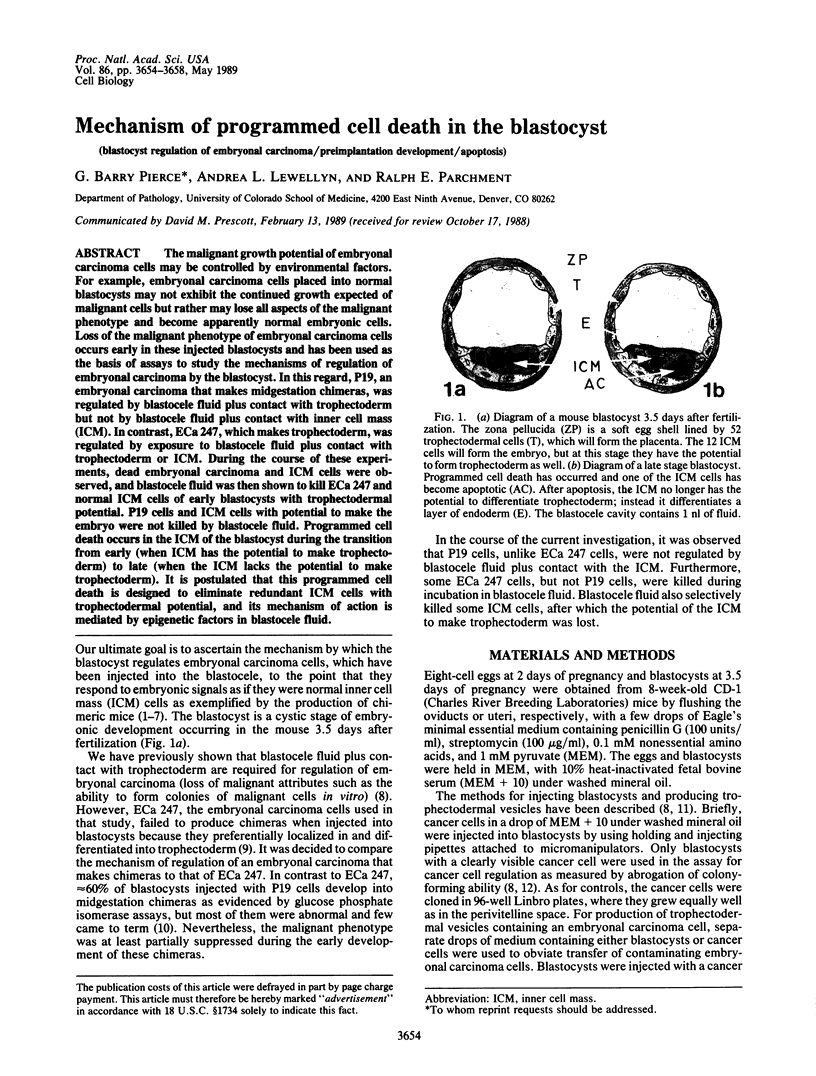
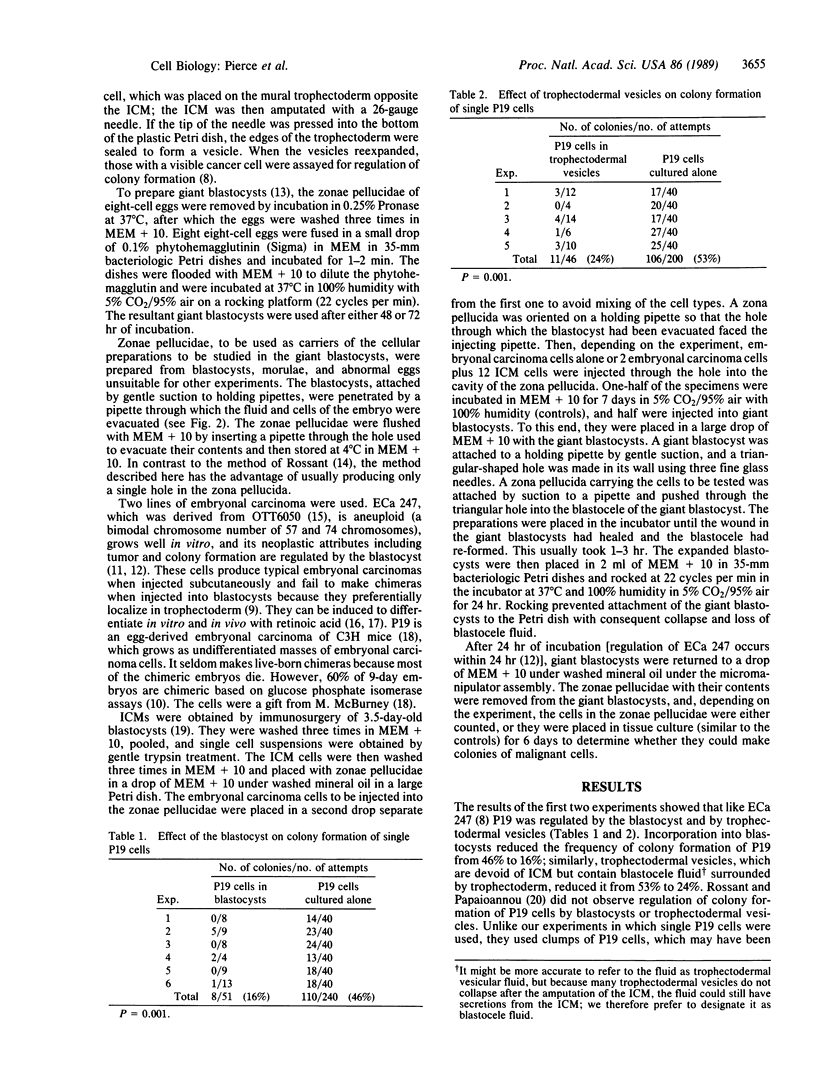
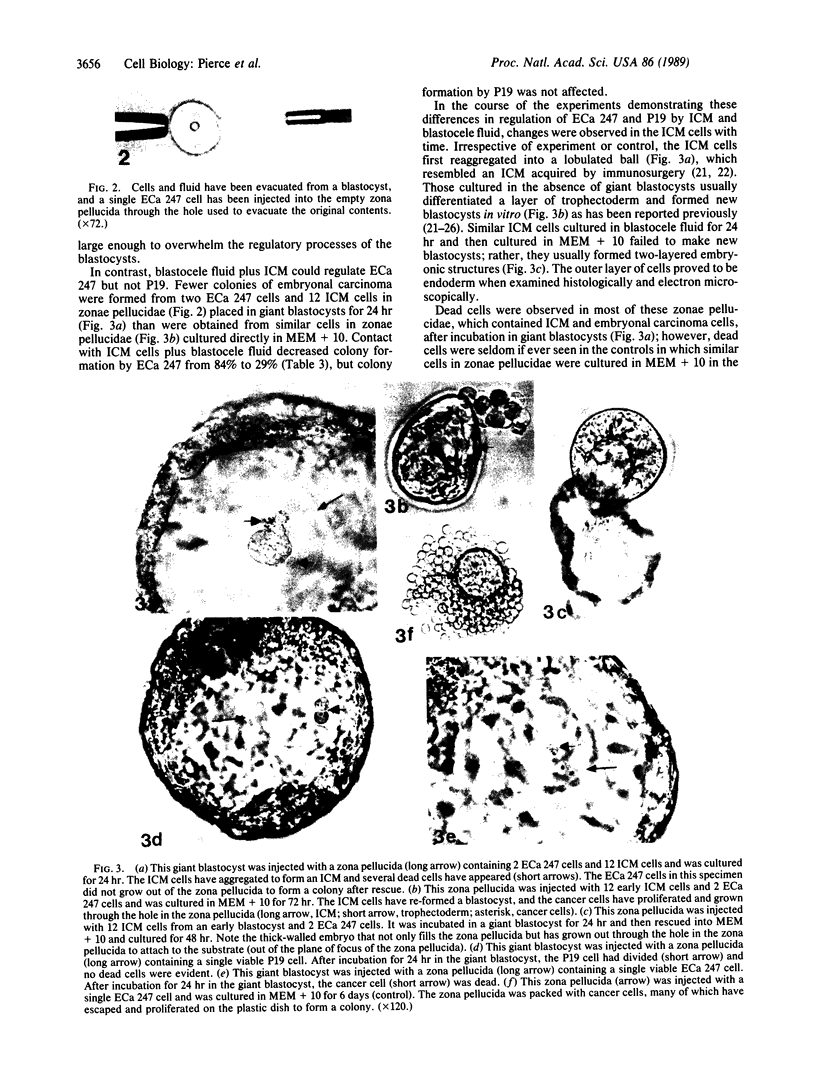
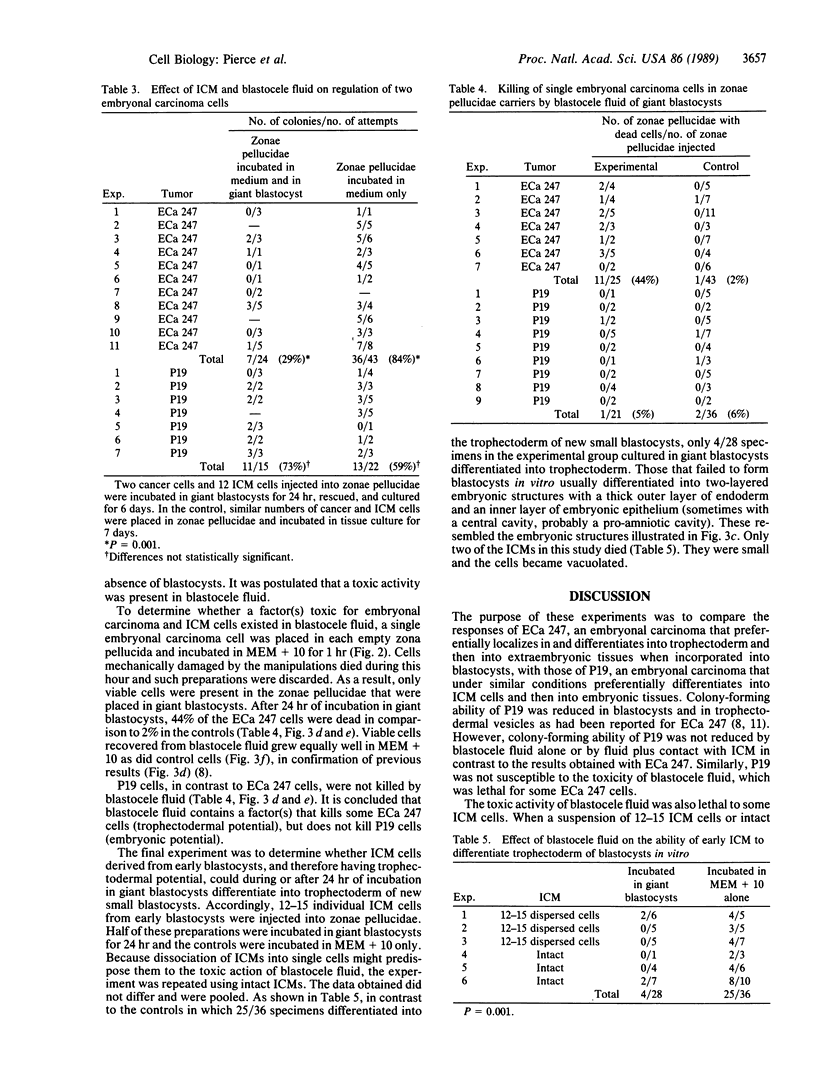
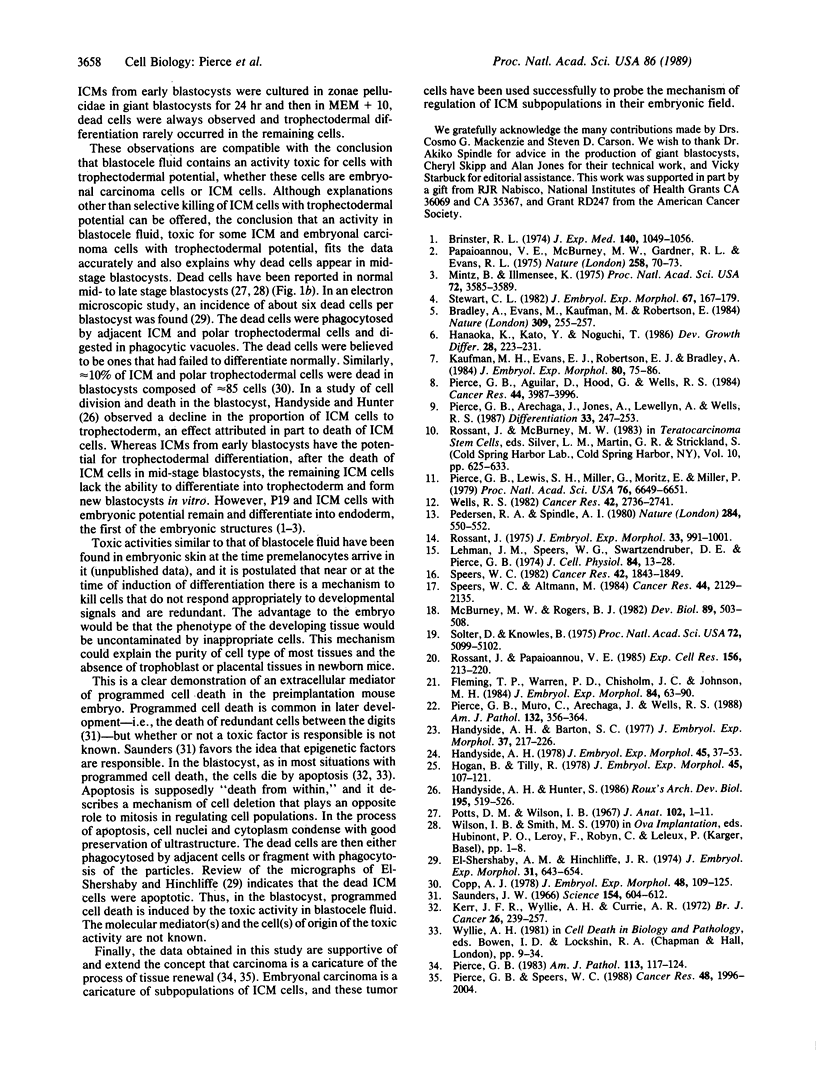
Images in this article
Selected References
These references are in PubMed. This may not be the complete list of references from this article.
- Bradley A., Evans M., Kaufman M. H., Robertson E. Formation of germ-line chimaeras from embryo-derived teratocarcinoma cell lines. Nature. 1984 May 17;309(5965):255–256. doi: 10.1038/309255a0. [DOI] [PubMed] [Google Scholar]
- Brinster R. L. The effect of cells transferred into the mouse blastocyst on subsequent development. J Exp Med. 1974 Oct 1;140(4):1049–1056. doi: 10.1084/jem.140.4.1049. [DOI] [PMC free article] [PubMed] [Google Scholar]
- Copp A. J. Interaction between inner cell mass and trophectoderm of the mouse blastocyst. I. A study of cellular proliferation. J Embryol Exp Morphol. 1978 Dec;48:109–125. [PubMed] [Google Scholar]
- El-Shershaby A. M., Hinchliffe J. R. Cell redundancy in the zona-intact preimplantation mouse blastocyst: a light and electron microscope study of dead cells and their fate. J Embryol Exp Morphol. 1974 Jun;31(3):643–654. [PubMed] [Google Scholar]
- Fleming T. P., Warren P. D., Chisholm J. C., Johnson M. H. Trophectodermal processes regulate the expression of totipotency within the inner cell mass of the mouse expanding blastocyst. J Embryol Exp Morphol. 1984 Dec;84:63–90. [PubMed] [Google Scholar]
- Handyside A. H., Barton S. C. Evaluation of the technique of immunosurgery for the isolation of inner cell masses from mouse blastocysts. J Embryol Exp Morphol. 1977 Feb;37(1):217–226. [PubMed] [Google Scholar]
- Handyside A. H. Time of commitment of inside cells isolated from preimplantation mouse embryos. J Embryol Exp Morphol. 1978 Jun;45:37–53. [PubMed] [Google Scholar]
- Hogan B., Tilly R. In vitro development of inner cell masses isolated immunosurgically from mouse blastocysts. II. Inner cell masses from 3.5- to 4.0-day p.c. blastocysts. J Embryol Exp Morphol. 1978 Jun;45:107–121. [PubMed] [Google Scholar]
- Kaufman M. H., Evans M. J., Robertson E. J., Bradley A. Influence of injected pluripotential (EK) cells on haploid and diploid parthenogenetic development. J Embryol Exp Morphol. 1984 Apr;80:75–86. [PubMed] [Google Scholar]
- Kerr J. F., Wyllie A. H., Currie A. R. Apoptosis: a basic biological phenomenon with wide-ranging implications in tissue kinetics. Br J Cancer. 1972 Aug;26(4):239–257. doi: 10.1038/bjc.1972.33. [DOI] [PMC free article] [PubMed] [Google Scholar]
- Lehman J. M., Speers W. C., Swartzendruber D. E., Pierce G. B. Neoplastic differentiation: characteristics of cell lines derived from a murine teratocarcinoma. J Cell Physiol. 1974 Aug;84(1):13–27. doi: 10.1002/jcp.1040840103. [DOI] [PubMed] [Google Scholar]
- McBurney M. W., Rogers B. J. Isolation of male embryonal carcinoma cells and their chromosome replication patterns. Dev Biol. 1982 Feb;89(2):503–508. doi: 10.1016/0012-1606(82)90338-4. [DOI] [PubMed] [Google Scholar]
- Mintz B., Illmensee K. Normal genetically mosaic mice produced from malignant teratocarcinoma cells. Proc Natl Acad Sci U S A. 1975 Sep;72(9):3585–3589. doi: 10.1073/pnas.72.9.3585. [DOI] [PMC free article] [PubMed] [Google Scholar]
- Papaioannou V. E., McBurney M. W., Gardner R. L., Evans M. J. Fate of teratocarcinoma cells injected into early mouse embryos. Nature. 1975 Nov 6;258(5530):70–73. doi: 10.1038/258070a0. [DOI] [PubMed] [Google Scholar]
- Pedersen R. A., Spindle A. I. Role of the blastocoele microenvironment in early mouse embryo differentiation. Nature. 1980 Apr 10;284(5756):550–552. doi: 10.1038/284550a0. [DOI] [PubMed] [Google Scholar]
- Pierce G. B., Aguilar D., Hood G., Wells R. S. Trophectoderm in control of murine embryonal carcinoma. Cancer Res. 1984 Sep;44(9):3987–3996. [PubMed] [Google Scholar]
- Pierce G. B., Arechaga J., Jones A., Lewellyn A., Wells R. S. The fate of embryonal-carcinoma cells in mouse blastocysts. Differentiation. 1987;33(3):247–253. doi: 10.1111/j.1432-0436.1987.tb01564.x. [DOI] [PubMed] [Google Scholar]
- Pierce G. B., Arechaga J., Muro C., Wells R. S. Differentiation of ICM cells into trophectoderm. Am J Pathol. 1988 Aug;132(2):356–364. [PMC free article] [PubMed] [Google Scholar]
- Pierce G. B., Lewis S. H., Miller G. J., Moritz E., Miller P. Tumorigenicity of embryonal carcinoma as an assay to study control of malignancy by the murine blastocyst. Proc Natl Acad Sci U S A. 1979 Dec;76(12):6649–6651. doi: 10.1073/pnas.76.12.6649. [DOI] [PMC free article] [PubMed] [Google Scholar]
- Pierce G. B., Speers W. C. Tumors as caricatures of the process of tissue renewal: prospects for therapy by directing differentiation. Cancer Res. 1988 Apr 15;48(8):1996–2004. [PubMed] [Google Scholar]
- Pierce G. B. The cancer cell and its control by the embryo. Rous-Whipple Award lecture. Am J Pathol. 1983 Oct;113(1):117–124. [PMC free article] [PubMed] [Google Scholar]
- Potts D. M., Wilson I. B. The preimplantation conceptus of the mouse at 90 hours post coitum. J Anat. 1967 Nov;102(Pt 1):1–11. [PMC free article] [PubMed] [Google Scholar]
- Rossant J. Investigation of the determinative state of the mouse inner cell mass. II. The fate of isolated inner cell masses transferred to the oviduct. J Embryol Exp Morphol. 1975 Jul;33(4):991–1001. [PubMed] [Google Scholar]
- Rossant J., Papaioannou V. E. Outgrowth of embryonal carcinoma cells from injected blastocysts in vitro correlates with abnormal chimera development in vivo. Exp Cell Res. 1985 Jan;156(1):213–220. doi: 10.1016/0014-4827(85)90275-7. [DOI] [PubMed] [Google Scholar]
- Saunders J. W., Jr Death in embryonic systems. Science. 1966 Nov 4;154(3749):604–612. doi: 10.1126/science.154.3749.604. [DOI] [PubMed] [Google Scholar]
- Solter D., Knowles B. B. Immunosurgery of mouse blastocyst. Proc Natl Acad Sci U S A. 1975 Dec;72(12):5099–5102. doi: 10.1073/pnas.72.12.5099. [DOI] [PMC free article] [PubMed] [Google Scholar]
- Speers W. C., Altmann M. Chemically induced differentiation of murine embryonal carcinoma in vivo: transplantation of differentiated tumors. Cancer Res. 1984 May;44(5):2129–2135. [PubMed] [Google Scholar]
- Speers W. C. Conversion of malignant murine embryonal carcinomas to benign teratomas by chemical induction of differentiation in vivo. Cancer Res. 1982 May;42(5):1843–1849. [PubMed] [Google Scholar]
- Stewart C. L. Formation of viable chimaeras by aggregation between teratocarcinomas and preimplantation mouse embryos. J Embryol Exp Morphol. 1982 Feb;67:167–179. [PubMed] [Google Scholar]
- Wells R. S. An in vitro assay for growth regulation of embryonal carcinoma by the blastocyst. Cancer Res. 1982 Jul;42(7):2736–2741. [PubMed] [Google Scholar]





